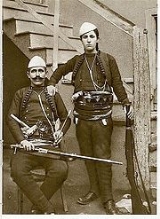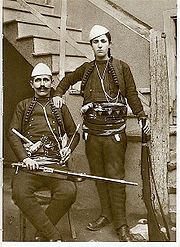
Azem Galica
Encyclopedia

Albanians
Albanians are a nation and ethnic group native to Albania and neighbouring countries. They speak the Albanian language. More than half of all Albanians live in Albania and Kosovo...
nationalist and rebel who fought for the unification of Kosovo with Albania.
Life
Bejta was born in the village of Galica (medieval Kalica) in the DrenicaDrenica
Drenica also known as the Drenica Valley, is a hilly region in central Kosovo, covering . Located west of the capital Prishtina, its population of 110,000 is largely ethnic-Albanian....
region of central Kosovo
Kosovo
Kosovo is a region in southeastern Europe. Part of the Ottoman Empire for more than five centuries, later the Autonomous Province of Kosovo and Metohija within Serbia...
. He was the son of Bejta Galica, a patriot who died fighting against the Ottoman Empire
Ottoman Empire
The Ottoman EmpireIt was usually referred to as the "Ottoman Empire", the "Turkish Empire", the "Ottoman Caliphate" or more commonly "Turkey" by its contemporaries...
and for Albania
Albania
Albania , officially known as the Republic of Albania , is a country in Southeastern Europe, in the Balkans region. It is bordered by Montenegro to the northwest, Kosovo to the northeast, the Republic of Macedonia to the east and Greece to the south and southeast. It has a coast on the Adriatic Sea...
's separation from the Serbian state. Azem followed his father, and first fought against the Serbs between 1912-1914.
Resistance against Serbia (1912-1915)
The same year, 1912, SerbiaKingdom of Serbia
The Kingdom of Serbia was created when Prince Milan Obrenović, ruler of the Principality of Serbia, was crowned King in 1882. The Principality of Serbia was ruled by the Karađorđevic dynasty from 1817 onwards . The Principality, suzerain to the Porte, had expelled all Ottoman troops by 1867, de...
gained Kosovo in the course of the First Balkan War
First Balkan War
The First Balkan War, which lasted from October 1912 to May 1913, pitted the Balkan League against the Ottoman Empire. The combined armies of the Balkan states overcame the numerically inferior and strategically disadvantaged Ottoman armies and achieved rapid success...
, and Azem Galica was among the few Albanians who fought against the Serbs.
Colaboration with Bulgaria and Austria-Hungary (1915-1918)
During the First World War, when the Serbs were defeated by the BulgariansKingdom of Bulgaria
The Kingdom of Bulgaria was established as an independent state when the Principality of Bulgaria, an Ottoman vassal, officially proclaimed itself independent on October 5, 1908 . This move also formalised the annexation of the Ottoman province of Eastern Rumelia, which had been under the control...
and Austro-Hungarians
Austria-Hungary
Austria-Hungary , more formally known as the Kingdoms and Lands Represented in the Imperial Council and the Lands of the Holy Hungarian Crown of Saint Stephen, was a constitutional monarchic union between the crowns of the Austrian Empire and the Kingdom of Hungary in...
in 1915, Kosovo was divided between Bulgaria and Austro-Hungary. Azem Galica accepted this occupation, and he became an outlaw fighting again the soldiers and police of Kingdom of Yugoslavia after First World War.

